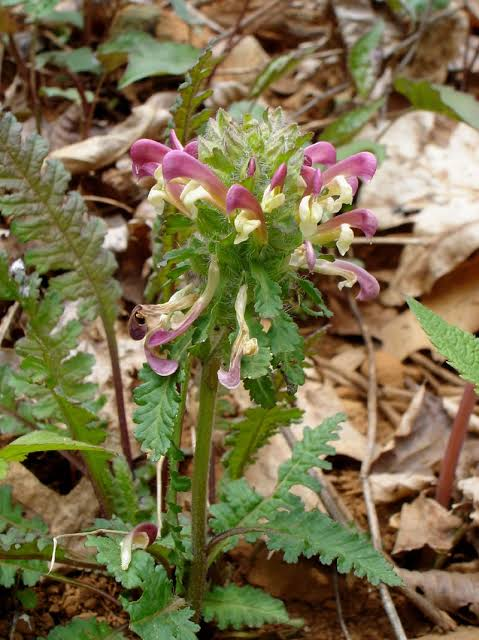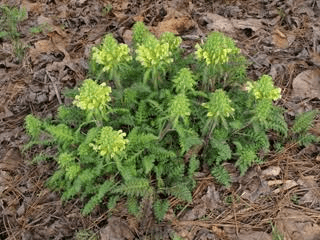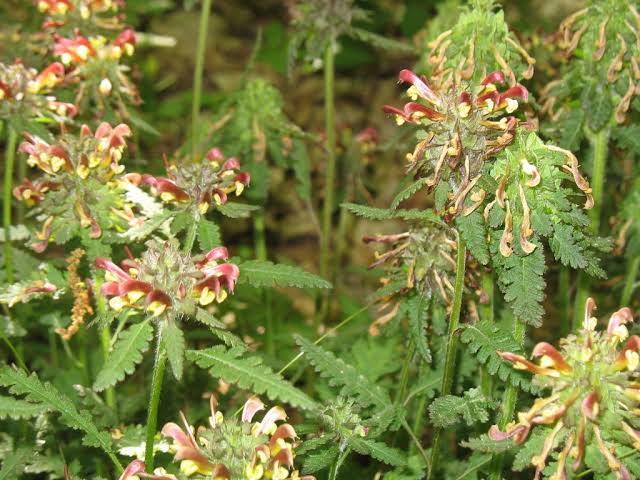Pedicularis canadensis, commonly known as Wood Betony, stands out as a natural marvel. This article delves into the depths of this remarkable herb, exploring its rich history, botanical intricacies, and the myriad medicinal health benefits it offers. Derived from the Greek word “pediculus,” meaning louse, due to the belief that the plant could cure lice infestations, Pedicularis canadensis has a storied past intertwined with traditional medicine and healing practices.
History of Pedicularis canadensis
Before we embark on the journey to understand the medicinal wonders of Pedicularis canadensis, it’s essential to comprehend its historical significance. Throughout centuries, indigenous communities and herbalists have revered this plant for its healing properties. Native to North America, Wood Betony has been an integral part of traditional medicine among various indigenous tribes, including the Cherokee and Iroquois nations.
Historically, Pedicularis canadensis was utilized for a wide array of ailments, ranging from headaches and respiratory issues to digestive disorders. Its leaves and flowers were often brewed into teas or tinctures, creating potent remedies that offered relief and healing to those in need.
The Botanical Description of Pedicularis canadensis
1. Life: Pedicularis canadensis, a perennial herbaceous plant, belongs to the Orobanchaceae family. This striking herb boasts vibrant green leaves and delicate, tubular flowers, ranging in color from pale pink to deep purple. Its slender stems rise gracefully, bearing clusters of these enchanting blossoms.
In indigenous cultures, Wood Betony held significant importance. The herb was revered for its ability to alleviate headaches, making it a popular choice for natural pain relief. Additionally, it was used to address respiratory ailments, demonstrating its versatility as a healing agent. The leaves and flowers were carefully harvested and prepared into infusions, preserving the plant’s medicinal properties.
2. Habitat: Wood Betony is predominantly found in woodland areas, thriving in moist, well-drained soil. Its ability to adapt to various soil types contributes to its widespread presence in North American forests. Look for it in the dappled sunlight of deciduous woods, where it emerges as a beacon of natural beauty.
In contemporary herbal medicine, Pedicularis canadensis continues to be valued for its therapeutic potential. Its natural compounds are believed to possess anti-inflammatory and analgesic properties, making it a valuable ingredient in herbal remedies aimed at reducing pain and inflammation. Furthermore, its calming effects on the nervous system have led to its inclusion in stress-relief formulations, promoting relaxation and overall well-being.
3. Morphology: The leaves of Pedicularis canadensis are deeply serrated, adding to its ornamental allure. Its flowers, arranged in dense spikes, create a captivating display, attracting pollinators like bees and butterflies. The plant’s root system is robust, allowing it to anchor firmly into the ground and absorb essential nutrients from the soil. As we conclude this exploration into the botanical marvel that is Pedicularis canadensis, it becomes evident that its historical significance and medicinal prowess are deserving of admiration.
From its traditional uses in indigenous healing practices to its integration into modern herbal medicine, Wood Betony continues to captivate herbalists and nature enthusiasts alike. Incorporating the knowledge of this extraordinary plant into our lives not only honors centuries-old traditions but also empowers us to embrace the bountiful gifts nature provides. As we appreciate the intricate beauty of Pedicularis canadensis, let us remember the wisdom of our ancestors and the healing potential found within the embrace of the natural world.
The Geographic Distribution of Pedicularis canadensis
1. Range: Pedicularis canadensis, commonly known as Wood Betony, exhibits a widespread geographic distribution across North America. This herbaceous perennial is primarily found in eastern and central North America, stretching from the eastern United States to as far north as Canada, and as far south as the southern United States. It thrives in a variety of woodland habitats and is especially abundant in deciduous forests.
2. Preferred Habitat: Wood Betony shows a predilection for shaded, moist environments with well-drained soils. It’s frequently spotted in the understorey of woodlands, where it can receive dappled sunlight, creating an ideal microhabitat for its growth. This distribution allows for a consistent presence of Pedicularis canadensis in numerous natural ecosystems.
3. Ecological Significance: In its geographic distribution, Pedicularis canadensis plays a significant role in the ecology of these regions. Its nectar-rich flowers attract pollinators like bees and butterflies, contributing to the pollination of various plant species. Moreover, the plant’s presence in forests helps stabilize the soil and maintain ecosystem balance.
The Chemical Composition of Pedicularis canadensis
1. Phytochemical Profile: The chemical composition of Pedicularis canadensis is a subject of interest among researchers and herbalists. It contains a variety of phytochemicals, including iridoids, flavonoids, and tannins. These compounds are believed to contribute to the herb’s medicinal properties, such as anti-inflammatory and analgesic effects.
2. Iridoids: Iridoids, like harpagide and aucubin, are found in Wood Betony and are known for their anti-inflammatory properties. They may help reduce pain and inflammation, making Pedicularis canadensis a valuable addition to herbal remedies.
3. Flavonoids: Flavonoids are natural antioxidants found in this plant. They play a role in neutralizing harmful free radicals and protecting cells from oxidative stress, which is linked to various chronic diseases.
4. Tannins: Tannins are astringent compounds that can have a drying effect. In the context of Wood Betony, they may be responsible for some of its traditional uses, particularly in addressing digestive issues.
The Harvesting and Processing of Pedicularis canadensis
1. Sustainable Harvesting: The harvesting of Pedicularis canadensis is a process that requires care and sustainability. To ensure the survival of this valuable plant, it’s crucial to follow responsible harvesting practices. Harvest the aerial parts of the plant, such as leaves and flowers, without uprooting it. This allows the plant to continue thriving and fulfilling its ecological role.
2. Air Drying: After harvesting, the plant material should be carefully cleaned and air-dried in a well-ventilated space. Proper drying is essential to preserve the herb’s medicinal properties and prevent mold or spoilage.
3. Preparation for Use: Once dried, Wood Betony can be used in various forms, including teas, tinctures, or capsules. Depending on the intended application, the herb can be combined with other complementary herbs to create herbal blends.
These comprehensive details regarding the geographic distribution, chemical composition, and harvesting and processing of Pedicularis canadensis provide a holistic understanding of this remarkable plant and its significance in the world of herbal medicine and ecology.
Read Also: How to Start a Small-Scale Farm: What You Need to Know
The Medicinal Health Benefits Of Pedicularis canadensis (Wood Betony)

1. Pain Relief: Wood Betony has been traditionally used to alleviate various types of pain, including headaches and muscle aches. Its natural compounds, such as iridoids, possess analgesic properties that make it a valuable herb for pain management.
2. Anti-Inflammatory Properties: The anti-inflammatory effects of Pedicularis canadensis are attributed to compounds like harpagide and aucubin. These properties are beneficial for reducing inflammation and may be helpful in conditions like arthritis.
3. Stress Reduction: Wood Betony has a calming effect on the nervous system, which can help reduce stress and anxiety. It’s often used in herbal formulations aimed at promoting relaxation and overall well-being.
4. Respiratory Health: Traditional uses of Wood Betony include addressing respiratory issues. It can be beneficial for conditions like coughs and bronchitis, offering relief and supporting respiratory health.
5. Digestive Aid: Tannins found in Pedicularis canadensis contribute to its astringent properties. This makes it useful in addressing digestive problems, such as diarrhea and indigestion.
6. Wound Healing: In some traditional practices, Wood Betony was applied topically to wounds and skin irritations to promote healing and reduce inflammation.
7. Antioxidant Benefits: The flavonoids in Wood Betony act as antioxidants, protecting cells from oxidative stress and contributing to overall health.
8. Immune System Support: By reducing inflammation and providing antioxidant support, Pedicularis canadensis can indirectly boost the immune system, helping the body ward off infections.
9. Sleep Aid: Due to its calming effects, Wood Betony may also assist in improving sleep quality and managing insomnia.
10. Headache Relief: Wood Betony’s historical use in treating headaches is a testament to its effectiveness in this regard.
11. Menstrual Cramp Relief: For individuals experiencing menstrual cramps, the analgesic properties of this herb can provide relief and comfort.
12. Anti-Anxiety: The calming impact of Wood Betony extends to anxiety reduction, making it a valuable herb for stress management.
13. Anti-Spasmodic: It may help relax muscle spasms and reduce muscle tension.
14. Antiseptic Properties: Topical applications of Wood Betony may offer antiseptic benefits when applied to minor cuts and abrasions.
15. Anti-Rheumatic: Its anti-inflammatory properties can be useful for those dealing with rheumatic conditions.
16. Skin Health: Wood Betony may contribute to improved skin health through its wound-healing and anti-inflammatory effects.
17. Cognitive Health: Some herbalists suggest that the calming properties of Pedicularis canadensis may benefit cognitive function, reducing mental stress.
18. Cardiovascular Health: The antioxidant effects of Wood Betony can positively impact heart health by reducing oxidative stress and inflammation.
The Methods of Usage to Achieve the Provided Health Benefits Of Pedicularis canadensis (Wood Betony)
1. Herbal Tea: Wood Betony leaves and flowers can be dried and used to make herbal teas. This is a common method to ingest the herb and enjoy its calming and healing properties.
2. Tinctures: Tinctures are concentrated liquid extracts of the herb. They are easy to use and allow for precise dosing.
3. Capsules: For convenience, Wood Betony can be encapsulated for easy consumption. This is a suitable option for those who prefer a standardized dosage.
4. Topical Applications: When addressing skin conditions or wound healing, Wood Betony can be applied topically as a poultice or infused oil.
5. Smoking Blend: In some traditional practices, Wood Betony has been included in smoking blends for its calming effects.
6. Culinary Use: Wood Betony can also be used in culinary creations, adding a unique flavor to dishes while offering potential health benefits.
The Side Effects Of Using Pedicularis canadensis Medicinal Plant
1. Allergic Reactions: Some individuals may be sensitive or allergic to Wood Betony, resulting in skin rashes, itching, or other allergic symptoms.
2. Gastrointestinal Discomfort: In rare cases, excessive consumption of Wood Betony may lead to digestive discomfort, including nausea and diarrhea.
3. Interactions: Wood Betony may interact with certain medications, so it’s advisable to consult a healthcare professional before use, especially if you’re taking prescription drugs.
4. Pregnancy and Lactation: Pregnant and nursing individuals should use Wood Betony with caution, as its effects during these periods are not well-studied.
5. Not for Long-Term Use: Prolonged or excessive use of Wood Betony is not recommended due to a lack of long-term safety data.
6. Sedation: The herb’s calming properties may cause drowsiness in some individuals, so it’s essential to avoid activities requiring alertness after consumption.
7. Avoid if Allergic to Lamiaceae: Wood Betony belongs to the Lamiaceae family, so individuals with known allergies to this plant family should exercise caution or avoid it.
Read Also: 17 Medicinal Health Benefits Of Mentzelia Multiflora (Adonis blazingstar)
The Scientific Research and Studies of Pedicularis canadensis (Wood Betony)

1. Pain Management Studies: Scientific research has explored Wood Betony’s effectiveness in pain management, particularly in the context of headaches and muscle pain. Studies have investigated its analgesic properties and their potential applications.
2. Anti-Inflammatory Effects: Research has delved into the anti-inflammatory properties of Pedicularis canadensis, shedding light on how it may help reduce inflammation in various conditions, including arthritis.
3. Phytochemical Analysis: Studies have focused on the herb’s chemical composition, identifying key compounds like iridoids and flavonoids. This research enhances our understanding of Wood Betony’s medicinal potential.
4. Ethnobotanical Studies: Ethnobotanical research has documented the historical and cultural uses of Wood Betony among indigenous communities, providing insights into traditional practices and remedies.
5. Pharmacological Investigations: Scientific investigations have examined Wood Betony’s pharmacological effects on the nervous system, exploring its potential in stress reduction and anxiety management.
The Safety Precautions and Recommendations In Using Pedicularis canadensis (Wood Betony) Medicinal Plant
1. Allergy Testing: Before using Wood Betony, especially if you’re new to it, conduct an allergy test to ensure you don’t have a sensitivity or allergy to the herb.
2. Dosage Considerations: Carefully follow recommended dosages to prevent adverse effects. Excessive consumption may lead to digestive discomfort or drowsiness.
3. Consult a Healthcare Professional: If you’re pregnant, nursing, or taking prescription medications, consult with a healthcare professional before using Wood Betony.
4. Avoid Prolonged Use: Wood Betony is not recommended for long-term or excessive use due to limited long-term safety data.
5. Maintain Alertness: Be cautious when using Wood Betony, as it may induce sedation in some individuals. Avoid activities requiring full alertness after consumption.
FAQs About Pedicularis canadensis (Wood Betony) Medicinal Plant
1. What Are the Key Medicinal Benefits of Wood Betony?
Wood Betony offers various benefits, including pain relief, anti-inflammatory effects, stress reduction, and respiratory health support.
2. How Can I Use Wood Betony Safely?
To use Wood Betony safely, follow recommended dosages, conduct an allergy test, and consult a healthcare professional if you’re pregnant, nursing, or taking medications.
3. Can I Use Wood Betony for Long Periods?
It’s not advisable to use Wood Betony for extended periods due to a lack of long-term safety data.
4. Does Wood Betony Interact with Medications?
Wood Betony may interact with certain medications, so consult a healthcare professional if you’re taking prescription drugs.
5. Are There Any Known Side Effects of Wood Betony?
Possible side effects include allergic reactions, gastrointestinal discomfort, and sedation in some individuals.
6. How Can I Prepare Wood Betony Tea?
To prepare Wood Betony tea, steep dried leaves and flowers in hot water for about 10-15 minutes. Strain and enjoy.
7. Is Wood Betony Safe for Children?
Consult a healthcare professional before giving Wood Betony to children, as safety considerations may vary.
8. Where Can I Find Wood Betony for Purchase?
Wood Betony can be found in health food stores, online herbal shops, or you can cultivate it in your own garden.
9. Can I Use Wood Betony Alongside Other Herbal Remedies?
Combining Wood Betony with other herbal remedies is possible, but consult with a herbalist or healthcare professional for guidance.
10. What Does Wood Betony Taste Like?
Wood Betony has a slightly bitter and earthy taste, which some people find pleasant in herbal teas.
11. Are There Any Medicinal Traditions Associated with Wood Betony?
Wood Betony has a rich history of use in traditional medicine, particularly among indigenous communities in North America.
12. Can I Grow Wood Betony in My Garden?
Yes, you can cultivate Wood Betony in your garden, but ensure it receives the right conditions of shade and well-drained soil.
13. Does Wood Betony Have Culinary Uses?
Some people use Wood Betony in culinary creations for its unique flavor, although its primary use is medicinal.
14. Is Wood Betony Endangered or Protected?
Wood Betony is not considered endangered, but it’s essential to practice responsible harvesting to ensure its sustainability.
15. Does Wood Betony Have a Pleasant Aroma?
Wood Betony may have a mild, pleasant aroma when its leaves and flowers are crushed.
16. Can I Find Wood Betony in the Wild?
Yes, Wood Betony can be found in the wild, primarily in woodland areas in North America.
17. What Are the Historical Uses of Wood Betony?
Historically, Wood Betony was used to treat various ailments, including headaches, respiratory issues, and digestive disorders.
18. Can I Use Wood Betony for Skin Conditions?
Wood Betony may be applied topically to address skin irritations and promote wound healing, although consult with a healthcare professional for guidance on specific skin conditions.
Read Also: Best Ways to Properly Dispose Scrap Computer Wastes

